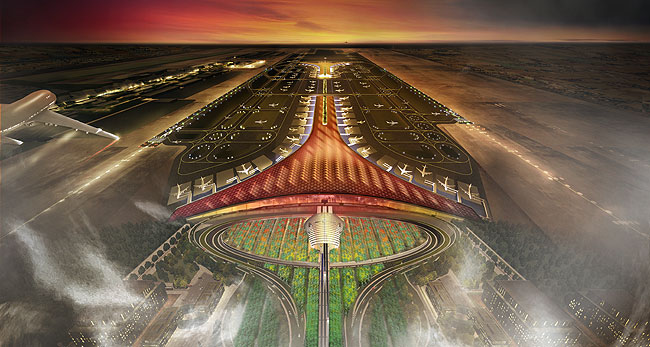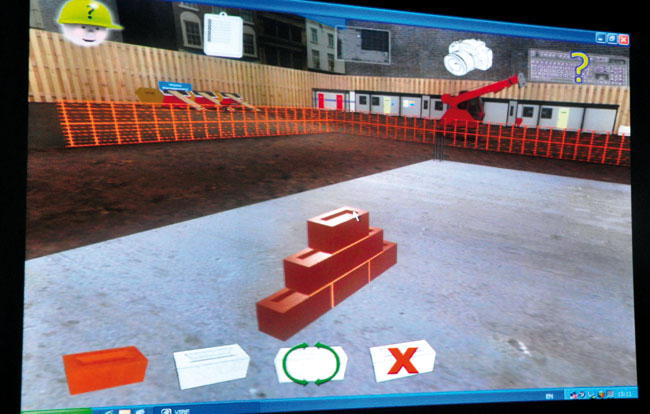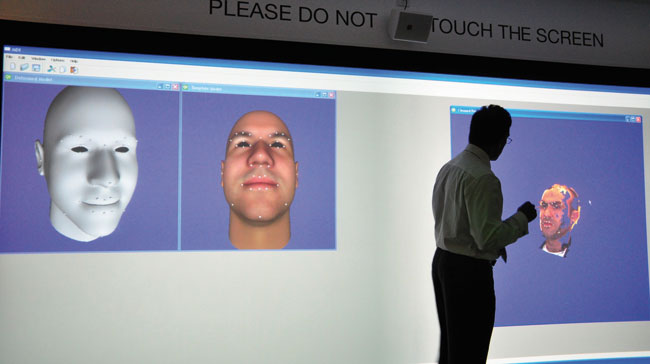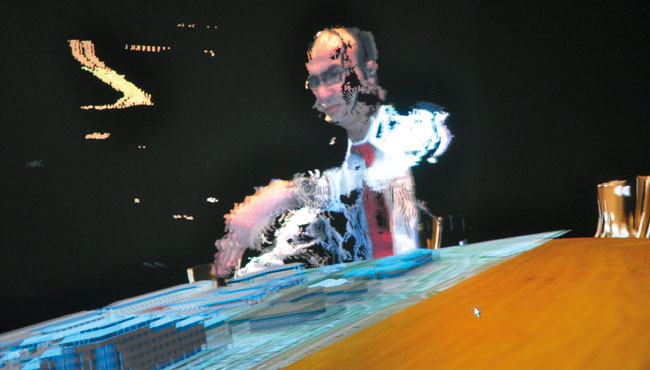Salford University is one of the leading international research institutes for Built Environment technology. The press was recently invited to visit its impressive facilities and gain an insight into the types of projects and research its academics and students undertake. Martyn Day reports.
It seems like only yesterday the industry was making the slow and painful move from drawing boards to 2D CAD systems. A migration to 3D was just a pipedream and, while the industry knew that the mode of working was highly inefficient, nothing was being done about it. Yet in a very short space of time, the breadth and scope of 3D technologies available to architects and those working in construction has mushroomed, with a corresponding increase in appetite to understand and deploy this new thinking.
One of the driving factors for this U-turn is the extreme challenges the industry is facing, which have never been more serious or complex. The economic downturn has put tremendous pressure on firms to cut costs and find new work, often for reduced fees. It may have been more than 10 years since Sir John Egan published his Rethinking Construction report, which called for radical improvement within the construction industry, but it would appear that painful economic conditions have been more persuasive in getting the industry to evaluate better ways of doing its business.
Many of the new 3D technologies are still embryonic, with best practice and processes to be fully worked out. Enter Salford University and its futuristic virtual environment centre for research into interaction and collaboration, called THINKlab. The institution has been engaged by commercial and academic customers to look at virtual urban planning, regeneration and digital design. Based in the north west of England, it has strong contacts with local businesses, together with the wider academic research community. The recent press open day was an outreach to tell the story of Salford University’s Built Environment research and explain a little about some of the projects the team has been working on.

As with nearly all British Universities, Salford campus is rather unremarkable with a mixture of 1960s and 1970s structures. There was little to prepare one for what had been done to the seventh floor of the Maxwell building. Walking out of the lift was like entering something from Star Trek with walls of lights, curved surfaces and glassed-off work areas. The THINKlab is a dedicated space where the Built Environment faculty has created a laboratory for research into technology-enabled collaboration and virtual technologies. Presentations were given in the THINKpod, an even more futuristic meeting room within the lab that bristles with the very latest in high resolution projection, tracking and immersive stereoscopic hardware.
We were welcomed by Professor Peter Brandon, director of the THINKlab. According to Brandon, the THINKlab is a place to challenge the existing and prevailing orthodoxy, to find new ideas and the best technology to suit our needs, which could lead to a new era of enlightenment. Brandon highlighted advances in instant communication, knowledge-based systems, better integration of systems and the removal of geographical boundaries as being driving forces to provide new machine-based support for the creation of knowledge.
Salford University’s vital statistics are impressive. Originating from the merger of multiple departments, the School of Built Environment was started in 2006 and now has 1,350 undergraduates and 309 postgraduates from 57 countries (175 of whom are doing PhDs). In total it has 69 staff, including 22 professors and 37 external visiting professors. Since 1993, Salford has been the base for the Foundation for the Research Institute of the Built and Human Environment and is the education partner for the government-sponsored Center of Education in the Built Environment (CEBE), as well as being the Centre for Construction Innovation, which links to 15,000 local firms. With a special focus on research, over the last five years Salford has brought in over £20 million in construction-related research funding.
The key areas of thought leadership that THINKlab is engaged in are wide and varied, and cover the threat of global warming, sustainable development, improved performance, changing social patterns and the change in the way built assets are managed. On pure technology development, expertise is being developed in Building Information Management, Virtual Environments, Future Workspaces, Off-site fabrication, distributed intelligence and procurement.
Following the introduction we were given a series of presentations by faculty members on a selection of the diverse range of projects that they are currently involved in.

Optimal learning spaces
Carl Abbott explained how Manchester City Council had asked for the latest ideas on the optimal design of primary schools. A team of experts from the built environment faculty at the University worked with the council on all the key areas that influence learning, covering everything from air quality, use of light, colour, layout, plants and acoustics. The net result will be new designs for places that assist the learning process taking into account physical and social criteria.
E-Readiness and IT maturity
Professor Mustafa Alshawi examined the current process and implementation of Building Information Modelling (BIM) systems that use a master model concept, together with the sophistication of other business systems such as Enterprise Resource Planning (ERP). According to studies as much as 80%-90% of IT investments do not meet their performance objectives. Prof Alshawi has designed a program to measure a company’s ‘e-Readiness’ prior to adopting process centric applications, checking the people, the organisation and the process to hopefully ensure a higher degree of success.
With an estimated market of £2 billion, rising to £20 billion in the next five years, a prefabrication research engagement was also highlighted by Prof Alshawi. ManuBuild, which makes pre-fabricated buildings, is looking to bring the building industry into the industrialised age by manufacturing pre-fabricated buildings and delivering them onsite. The development of training project simulators and dashboards using PDAs for project managers was explored, concentrating on the kinds of dynamic decisions that are frequently made on site.
Future collaborative workspaces
Using all the power of the THINKpod, Professor Terrence Fernando took us into a Virtual Workspace to see the research work on co-located, distributed and mobile collaboration.
In one live urban planning scenario, a user could physically interact with a 3D displayed city model. While at first we could see him as a video feed within the environment, Fernando then enabled the extraction of 3D data from this video, actually bringing in a 3D representation of the user. While quite jagged, the next phase involved mapping the user’s face to a human head mesh. This is the closest you will get, for the time being at least, to living in the ‘Matrix’.

Interactive learning
Over the past twelve months Salford has been working closely with the Specialist Schools and Academies Trust to produce interactive resources for 14-19 diplomas.
Built on games technology the researchers have come up with engaging and intuitive scenarios that back up traditional classroom work, together with matching employer needs. In the example shown, a student can navigate around a building site, visit the offices, read health and safety information, see schedules and examine the machinery. There is even a tutorial on how to lay bricks and make different patterns.
BIM and construction
Throughout many of the presentations it was clear that Salford has access to all the latest CAD tools, together with some of the very high-end solutions such as Gehry Technologies’ Digital Project, which is based on Dassault Systemes’ Catia engine.
Dr Tuba Kocaturk, programme director MSc Digital Architectural Design, gave a great insight into the wide scope of work undertaken, examining best practices in BIM and being at the cutting edge of free form generative modelling.
Salford University recently held a symposium on generative design, which attracted major architects from around the world. While the University only offers postgraduate courses at the moment, there are firm plans to offer degrees within a few years. Looking at the exemplary focus on digital design, Salford could become a real centre of excellence here.

Resilient homes
Professor Erik Bichard worked with the Environment Agency to study the needs for improved flood protection and energy conservation. One initiative is to offer households rewards for installing insulation and lowering power consumption by offering free local transport, fruit and vegetables, landscape gardening and tickets to sporting events.
Conclusion
While these presentations were only a small selection of the ongoing projects that Salford University is undertaking, the sheer breadth of topics was impressive. The two stand-out sessions for me were the immersive collaborative workspaces and the digital architecture overview. While Virtual Reality has become a bit of an overused term and a technology that has never really made it, the THINKlab demo proved that there are real applications now that design data is becoming increasingly 3D.
To be actively teaching and engaging with the Generative design family (Bentley Generative Components, Rhino Grasshopper, Gehry Digital Project), pushes Salford to only a handful of institutions in the world that are really at the cutting edge of digital design. Students with exposure to this technology will be a in a very small band of in-demand architects that get experience with the most expressive design systems under development. I really look forward to hearing more about the degree course Salford is planning.
Salford University obviously has a huge focus on research for the Built Environment. The dedication, enthusiasm and resources available obviously attract a lot of investment. The facilities not only look out of this world but are also the best I have seen at any university or company for that matter. Firms can use the THINKlab and THINKpod for collaborative design sessions or meetings and can engage with the Built Environment team to run their own research projects.






